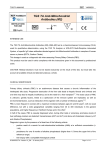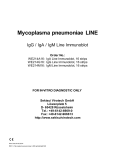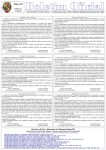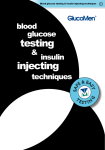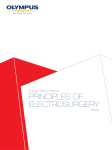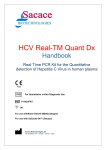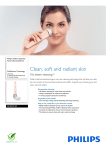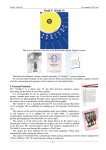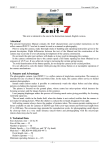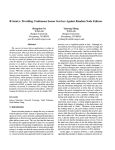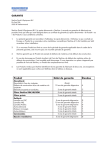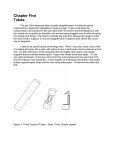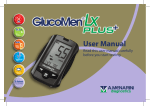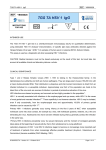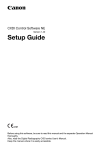Download PDF - Menarini Diagnostics
Transcript
ZENIT RA LKM-1 REF REF 46316 Distributed by ZENIT RA Anti-Mitochondrial Antibodies (M2) INSTRUCTIONS FOR USE 46316 50 USAGE The ZENIT RA Anti-Mitochondrial Antibodies (M2) (AMA-M2) test is a chemiluminescent immunoassay (CLIA) used for quantitative determination, using dedicated ZENIT RA Analyser instrumentation, of specific IgG class antibodies directed against Anti-Mitochondrial Antibodies in samples of human serum or plasma (EDTA, Sodium Citrate). This dosage is used as a diagnostic aid when assessing Primary Biliary Cirrhosis (PBC). CAUTION: Medical decisions must not be based exclusively on the result of this test, but must take into account all available clinical and laboratory data as a whole. CLINICAL SIGNIFICANCE Primary biliary cirrhosis (PBC) is an autoimmune disease that causes a chronic inflammation of the intrahepatic bile ducts. Progressive destruction of the liver cells leads to hepatic fibrosis and cirrhosis and 1,2 over time may lead to hepatic insufficiency and to the need for a liver transplant . The exact cause of PBC is unknown; genetic factors, linked to a dysfunction of the immune system are implicated, as well as environmental factors, such as interaction of the organism with a number of infectious agents 3,4,5 . 6 PBC is more frequent in women with a maximum incidence between ages 40 and 60 years , with no racial difference, but with a wide geographical variability ranging from 40 to 400 individuals in the general 7 populations, and higher frequency in Northern Europe and in the USA . In half of the cases, PBC is casually diagnosed when, during other tests or screening, anomalous levels of liver pathology markers are detected: transaminases (AST and ALT) and above all cholestasis indexes (γ-GT and Alkaline Phosphatasis). Diagnosis is given by the presence of at least two of the following criteria: - positive result of a search for anti-mitochondrial antibodies (AMA) at a sufficient concentration (> 1:40) - persistence for over 6 months of alkaline phosphatasis (higher than 1.5 times the upper limit of the reference range) - liver biopsy with a compatible histological context Definite PBC can be diagnosed when all three criteria are met, while the term probable PBC is used when 8 only two criteria are met . IFU059ZENIT RA – Version: 01 – 08 July 2014 Page 1 of 14 ZENIT RA LKM-1 REF 46316 High AMA titres are the most sensitive and specific PBC immune-serologic markers, since they can be found in 90-95% 9,10 of patients with a specificity close to 100%. However, it is worth underlining that the frequency 11 of the antibodies detected depends on the group studied and the sensitivity may be lower . Based on the immunochemical structure, 9 sub-types of mitochondrial antigens have been classified, named 12 from M1 to M9 . Only the anti-M2, anti-M4, anti-M8 and anti-M9 autoantibodies are specific to PBC and, of these, only the anti-M2 antibodies (specificity for pyruvate–dehydrogenase) are of diagnostic importance since they are present in high titres in almost all patients, while the other three may be found in low titres and 13 in any case are never found in isolation, but are always associated with anti-M2 antibodies . In reality, antigen M2 comprises 4 different autoantigens belonging to the structural complex of the pyruvate– 14 dehydrogenase enzyme , to which 4 different types of non cross-reagent antibodies correspond. The antibodies most frequently detected are those acting against the E2 (2-oxo acid dehydrogenase) 14 13 component ; those others are found less frequently and are normally associated with anti-E2 antibodies . The specific antigens have been identified as sub-units of the pyruvate–dehydrogenase complex (PDC-E2), of the 2-oxo acid dehydrogenase complex of the branched chain (BCOADC-E2) and of the 2-oxoglutarate dehydrogenase complex (OGDC-E2). The test to determine AMAs based on the use of the three combined antigens give higher performances than the IFA test, making it possible to detect AMA antibodies in over two thirds of the serums of PBC patients 15,16 who tested AMA negative with the IFA test . Since the presence of AMA antibodies may precede the onset of the symptomatic disease, the ability to identify more accurately the presence of the PBC marker 17,18 could contribute to early diagnosis and treatment and could slow down the progression of the disease . PRINCIPLE OF THE METHOD The ZENIT RA Anti-Mitochondrial Antibodies (M2) kit for quantitative determination of specific antimitochondrial antigen IgG employs an indirect two-step immunological method based on the principle of chemiluminescence. The specific antigen used to coat the magnetic particles (solid phase) and an anti-human IgG antibody are marked with an acridinium ester derivative (conjugate). During initial incubation, the specific antibodies present in the sample, in the calibrators or in the controls bond with the solid phase. During the second incubation, the conjugate reacts with the anti-M2 IgG antibodies sequestered by the solid phase. After each incubation, the material that has not bonded with the solid phase is removed by aspiration and subsequent washing. The quantity of marked conjugate that remains bonded to the solid phase is assessed by activation of the chemiluminescence reaction and measurement of the luminous signal. The generated signal, expressed in relative light units (RLU), is indicative of the concentration of specific antibodies present in the sample, in the calibrators and in the controls. IFU059ZENIT RA – Version: 01 – 08 July 2014 Page 2 of 14 ZENIT RA LKM-1 REF 46316 AUTOMATION The ZENIT RA Analyser instrument automatically performs all the operations envisaged by the dosage protocol: addition of samples, calibrators, controls, magnetic particles, conjugates and chemiluminescence activation solutions to the reaction container; magnetic separation and washing of particles; measurement of the light emitted. The system calculates the dosage results for the samples and controls by means of a stored calibration curve and prints a report that includes all the information related to the dosage and to the patient. MATERIALS AND REAGENTS Materials and reagents supplied REAG 1 MP 2.5 mL Magnetic particles coated with recombinant antigen containing immunodominant regions of PDC-E2, BCOADC-E2 and OGDC-E2 mitochondrials (MIT3) in Phosphate Buffer containing stabilising proteins, surfactant, Pro-Clin 300 and sodium azide (< 0.1 %) as preservatives. REAG 2 CONJ 15 mL Monoclonal anti-human IgG antibody marked with an acrinidium ester derivative (conjugate), in Phosphate Buffer containing stabilising proteins, surfactant, Pro-Clin 300 and sodium azide (< 0.1%) as preservative. REAG 3 4 DIL 25 mL x 2 bottles Sample Diluent Solution: Phosphate Buffer containing bovine serum albumin, a surfactant, an inert blue colouring agent, Pro-Clin 300 and Gentamicin SO4 as preservatives. REAG 5 CAL A 0.5 mL Human serum with low concentration of anti-M2 IgG antibodies containing sodium azide (< 0.1%) as preservative. REAG 6 CAL B 0.5 mL Human serum with high concentration of anti-M2 IgG antibodies containing sodium azide (< 0.1%) as preservative. All reagents are ready for use. Reagents 1, 2, 3 and 4 are assembled in a single kit forming the reagent cartridge. IFU059ZENIT RA – Version: 01 – 08 July 2014 Page 3 of 14 ZENIT RA LKM-1 REF 46316 The Calibrator concentrations are expressed in AU/mL (arbitrary units) and calibrated against an internal reference standard. The concentration settings, specific for each production batch, are recorded on the DATA DISK included in the kit. DATA DISK A Mini-CD containing data regarding all the products in the ZENIT RA line (Reagents, Calibrators, Control Serums) updated to the last production batch with the exclusion of products that have expired at the date when the new DATA DISK was compiled. Only the DATA DISK with the highest batch number needs to be kept to maintain the information required for correct operation of the system up to date. Materials and reagents required but not supplied in the kit: (1) - ZENIT RA Analyser - ZENIT RA Cuvette Cube Code No. 41400 (1) Code No. 41402 (2) Code No. 41409 Pack of 960 cuvettes - ZENIT RA System Liquid 1 bottle containing 5 litres of ready-to-use solution - ZENIT RA Wash Solution (2) Code No. 41407 1 bottle containing 10 litres of ready-to-use solution - ZENIT RA Trigger Set (2) Code No. 41403 1 250 mL-bottle of Trigger A (pre-trigger solution) 1 250 mL-bottle of Trigger B (trigger solution) - ZENIT RA D-SORB Solution Code No. 41436 Pack of 2 bottles containing 1 litre of ready-to-use solution. - ZENIT RA Cartridge Checking System - ZENIT RA Top Cap Set (2) Code No. 41401 Code No. 41566 300 red top caps to close the calibrator containers after first use. (1) Made by IDS France SAS, 42 rue Stéphane Mazeau, 21320 Pouilly en Auxois, France and distributed by A. Menarini Diagnostics Srl. (2) Made by IDS SA, 101-103 rue Ernest Solvay, 4000 Liège, BELGIUM and distributed by A. Menarini Diagnostics Srl. IFU059ZENIT RA – Version: 01 – 08 July 2014 Page 4 of 14 ZENIT RA LKM-1 REF 46316 Other Recommended Reagents ZENIT RA LIVER CONTROL SET Code No. 46317 Three 1 mL vials of negative human serum and three 1 mL vials of human serum positive for anti-AMA-M2 antibodies. WARNINGS AND PRECAUTIONS The reagents supplied in the ZENIT RA Anti-Mitochondrial Antibodies (M2) kit are only for in vitro diagnostic use and not for in vivo use in humans or animals. This product must be used in strict compliance with the instructions given in this document by professional users. Menarini cannot be held responsible for any losses or damages caused by use not in conformity with the instructions supplied. Safety precautions This product contains material of animal origin and therefore must be handled as if it contains infecting agents. This product contains components of human origin. All units of serum or plasma used to produce the reagents in this kit have been analysed with FDA-approved methods and found not to be reactive due to presence of HBsAg, anti-HCV, anti-HIV1 and anti-HIV2. However, since no analysis method is able to guarantee the absence of pathogenic agents, all material of human origin must be considered to be potentially infected and handled as such. In the event of damaged packaging or accidental leakage, decontaminate the area concerned with a diluted solution of sodium hypochlorite after putting on suitable personal protective equipment (overall, gloves, goggles). Dispose of the material use for the clean-up and of the packaging involved in the leakage according to national regulations for disposal of potentially infected waste. Some reagents contain sodium azide as a preservative. Since sodium azide may react with lead, copper and leaded brass forming explosive azides in piping, it is recommended that reagents or waste are not poured down drains but are disposed of in compliance with the national regulations on disposal of potentially hazardous waste. Operating precautions Reliable results can only be obtained by strictly complying with these instructions and scrupulously following what is written in the operating manual for the instrument. The reagents supplied in the kit must be used only with the ZENIT RA Analyser system. The components of the reagent cartridge must not be removed from the cartridge and reassembled. Do not use the kit after its use-by date. IFU059ZENIT RA – Version: 01 – 08 July 2014 Page 5 of 14 ZENIT RA LKM-1 REF 46316 PREPARATION OF THE REAGENTS The reagents supplied in the kit are all ready for use. PRESERVATION AND STABILITY OF THE REAGENTS Store the reagents supplied in the kit at 2-8°C in a vertical position in a dark place. In these conditions unopened reagent cartridge and calibrators are stable up to the use-by date. After opening the reagent cartridge can be used for 60 days if kept in a refrigerator at 2-8°C or in t he analyser. After opening, the calibrators can be used for 60 days if kept in a refrigerator at 2-8°C and if they have not been left in the analyser for more than 6 hours per session. Do not freeze the reagents and calibrators. PREPARATION AND PRESERVATION OF SAMPLES Dosage must be performed on samples of human serum and plasma (EDTA – Sodium Citrate). Use of lipaemic, haemolysed and turbid samples is not recommended. If the dosage is performed after more than 8 hours, separate the serum or the plasma from the clot, from the red globules and from the separating tubes with gel. Before being analysed, samples may be kept in a refrigerator at 2-8°C for a maximum of 7 days. If the dosage is to be performed after more than 7 days, store the samples frozen (< - 20°C). Avoid repeated freezing and thawing. OPERATING PROCEDURE Scrupulously follow the instructions given in the operating manual of the instrument to obtain reliable analytical results. Loading of reagents All the reagents supplied in the kit are all ready for use. Before inserting the reagent cartridge in the system, the magnetic particle container must be horizontally agitated by rotation in order to favour resuspension of the particles. Avoid generating foam when performing this operation. Place the reagent cartridge in the reagent area of the instrument using the guide provided and leave it to be agitated for at least 40 minutes before use. IFU059ZENIT RA – Version: 01 – 08 July 2014 Page 6 of 14 ZENIT RA LKM-1 REF 46316 Positioning of the reagent cartridge simultaneously determines reading of the identity bar-code. If the cartridge label is damaged or if it is not readable, the reagent cartridge identification data can be entered manually. The instrument automatically maintains the magnetic particles constantly agitated. If the reagent cartridge is removed from the instrument, store it at 2-8°C in a vertical position in a dark place. Loading of calibrators ZENIT RA calibrators are ready for use. Leave the calibrators at room temperature for 10 minutes and then gently shake the contents, either manually or using a vortex, avoiding the formation of foam. When using the calibrators for the first time, remove the guarantee seal and the white sealing cap before placing them in the analyser. If the calibrators have already been used, the container will have a top cap (red cap) with no guarantee seal. Remove the red closing cap before placing them in the analyser. Place the calibrators in the samples area of the analyser; see the analyser user manual on how to identify them in the analyser. Bar-code data must be entered manually if the label is damaged or if it is unreadable. The readings for the IgG class anti-AMA-M2 antibody concentration in the calibrators are recorded in the DATA DISK and automatically transferred to the analyser. At the end of the session, the calibrator containers must be closed with the top caps (red caps) provided and stored at 2-8°C until they are used again. The calibrators can be used for a maximum of four times. Loading of controls Place the controls in the samples area of the analyser. See the analyser user manual on how to identify them in the analyser. If there is no bar-code on the control or if it is not readable, the control identification data must be entered manually. If Zenit RA Controls are used, see the usage instructions provided. The readings for the anti-AMA-M2 IgG antibody concentration in the Zenit RA controls are recorded in the DATA DISK and automatically transferred to the analyser. Select the required parameters for each control. Loading of samples Place the samples in the samples area of the analyser; see the analyser user manual on how to identify them in the analyser. If there is no bar-code on the sample or if it is not readable, the sample identification data must be entered manually. Select the required parameters for each sample. Calibration The ZENIT RA Analyser instrument uses a memorised calibration curve (master curve), generated by the manufacturer for each batch of reagent cartridges. The “master curve” parameters, together with the calibrator concentration settings, are stored in the DATA DISK and transferred to the instrument’s data base. Calibrators A and B are used to recalibrate the “master curve” in both for the instrument used and for the reagents on board. IFU059ZENIT RA – Version: 01 – 08 July 2014 Page 7 of 14 ZENIT RA LKM-1 REF 46316 To perform recalibration analyse the two calibrators A and B in triplicate and the controls singly. The concentration readings obtained with the controls make it possible to validate the new calibration. Once recalibration of the “master curve” has been accepted and memorised, all subsequent samples can be analysed without any further calibration, except in the following cases: - when a reagent cartridge with a new batch number is loaded into the instrument; - when the control readings do not fall within the range of acceptability; - when the instrument maintenance procedure is performed; - when the validity of the recalibrated “master curve” has expired. The validity of the recalibrated “master curve” for the ZENIT RA Anti-Mitochondrial Antibodies (M2) kit is 21 days. Control of recalibration is performed automatically by the instrument. Dosage Press the start button. 1. The system aspirates 100µL of Sample Diluent, 40µL of Magnetic Particles, 80µL of Sample Diluent and 10µL of the sample, calibrators or control automatically pre-diluted by 1:10 by the instrument. The aspirated solutions and suspension are dispensed into the reaction cuvette. 2. The reaction cuvette is incubated in the rotor at 37°C for 10 minutes. 3. After this phase of incubation, the magnetic particles are separated and washed. 4. 200 µL of conjugate are dispensed into the cuvette. 5. The reaction cuvette is incubated in the rotor at 37°C for 10 minutes. 6. After this last phase of incubation, the magnetic particles are separated and washed and the cuvette is transferred to the reading chamber. 7. The quantity of conjugate bonded to the solid phase, expressed in RLU, is directly proportionate the concentration of anti-AMA-M2 IgG present in the sample. 8. The responses obtained are interpolated on the calibration curve and transformed into concentrations. QUALITY CONTROL To ensure the validity of the dosage, control serums at differing levels of concentration (at least one negative serum and one positive serum) must be measured every day in which dosage is performed. If your laboratory requires a more frequent use or a higher number of controls to check the dosage results, comply with the set quality control procedure. If ZENIT RA control serums are used, the expected average readings and the acceptability limits are those given on the DATA DISK included in the control pack too. If different control serums are used, before using them, the readings expected with ZENIT RA reagents and system must be defined. If the control reading does not fall within the specified range of acceptability, the related dosage results are not valid and the respective samples must be analysed again. In this case, before repeating the dosage, a recalibration procedure must be performed. IFU059ZENIT RA – Version: 01 – 08 July 2014 Page 8 of 14 ZENIT RA LKM-1 REF 46316 CALCULATION AND INTERPRETATION OF THE RESULTS Calculation of the results The concentration of the anti-AMA-M2 antibodies present in the samples that are being tested is automatically calculated by the system. The readings can be viewed on the display or printed. The concentrations are expressed in AU/mL. Calculation of the analyte concentration in the sample takes place by reading the response obtained for each sample on a calibration curve processed by a logistic “fitting” system with four parameters (4PL, Y weighted), periodically corrected according to the responses obtained for dosage of the calibrators. For detailed information on how the system calculates the results, please see the operating manual for the system. Interpretation of the results The dosage range measurable for ZENIT RA Anti-Mitochondrial Antibodies (M2) is: 0.0 – 1000 AU/mL. Readings lower than 0.0 AU/mL are extrapolated values, the message “OMR-” and/or ORA appears and they are shown as “equal to 0.0 AU/mL”. Readings higher than 1000 AU/mL are accompanied by the message “OMR+” and/or ORA and may be retested after suitable dilution. The results of the samples may be interpreted in the following way: (AU/mL) Interpretation < 10 The sample must be considered to be negative for anti-AMA-M2 IgG ≥ 10 The sample must be considered to be positive for anti-AMA-M2 IgG The above readings are to be considered only as suggested readings. Each laboratory must establish its own reference ranges. DOSAGE LIMITS For diagnostic purposes, the results obtained with the ZENIT RA Anti-Mitochondrial Antibodies (M2) kit and the ZENIT RA Analyser system must be used together with the other clinical and laboratory data available to the physician. Bacterial contamination of the sample and heat inactivation may influence the result of the dosage. Heterophyllous antibodies present in human serum samples may react with immunoglobulin-based reagents, causing interference with in vitro immunological dosages. Such samples may give rise to anomalous readings if analysed with the ZENIT RA Anti-Mitochondrial Antibodies (M2) kit. IFU059ZENIT RA – Version: 01 – 08 July 2014 Page 9 of 14 ZENIT RA LKM-1 REF 46316 EXPECTED READINGS The samples of 100 individuals selected randomly from the normal routine work of the laboratory were analysed to check the presence of anti-AMA-M2 IgG antibodies. All samples analysed proved negative, with an average reading of 0.7 AU/mL and a standard deviation of 1.5 AU/mL. Using the results obtained the “Limit of Blank” (LoB = the highest reading that can be expected in a series of samples that do not contain the analyte) was calculated. The “Limit of Blank”, determined as 95° perce ntile of the negative population, proved equal to 3.8 AU/mL with the Reagent batch no. 2. DIAGNOSTIC SENSITIVITY AND SPECIFICITY (CLINICAL) A total of 664 samples were tested with the ZENIT RA Anti-Mitochondrial Antibodies (M2) kit: 119 of the samples were from patients suffering from primary biliary cirrhosis (PBC), 66 from patients suffering from type 1 or type 2 autoimmune hepatitis (AIH-1 or AIH-2), 41 from patients with hepatitis C (HCV), 20 from patients with hepatitis B (HBV), 18 samples from patients with primary sclerosing cholangitis (PSC), while 400 samples were presumed normal, originating from routine laboratory testing. In the presumably negative population studied, including 66 samples from type 1 or type 2 autoimmune hepatitis (AIH-1 or AIH-2), 41 with hepatitis C (HCV), 20 with hepatitis B (HBV), 18 with primary sclerosing cholangitis (PSC) and 400 normal samples, 15 samples tested positive and 504 negative. - Diagnostic specificity: 97.2 % (530/545) Of the 15 samples that proved to be “not negative”, 8 belonged to the group of patients diagnosed with AIH-1 or AIH-2, 2 belonged to the group of patients diagnosed with HCV, and 5 to the group of normal samples. Of the 5 normal samples that tested positive, 4 were also confirmed positive by a commercial ELISA method. In the presumably positive population studied, including 119 samples from patients diagnosed with PBC, 87 proved to be positive and 32 samples were negative. - Diagnostic sensitivity: 73.1 % (87/119) Of the 32 samples that tested negative, 27 were also confirmed positive by a commercial ELISA method. Based on the diagnostic specificity and sensitivity results, the diagnostic agreement is 93.0 % (617/664). PERFORMANCES Caution: the data presented do not represent the operating specifications of the kit, but serve as experimental proof of how the kit works within these specifications in the manner envisaged by the manufacturer. Precision and Reproducibility The precision and the reproducibility of the ZENIT RA Anti-Mitochondrial Antibodies (M2) kit have been assessed using a protocol based on the guidelines given in Clinical and Laboratory Standards (CLSI) document EP5-A2. IFU059ZENIT RA – Version: 01 – 08 July 2014 Page 10 of 14 ZENIT RA LKM-1 REF 46316 The precision was calculated by analysing the results of 20 replicates of four serums (one negative and three positive with differing concentrations of anti-AMA-M2 IgG antibodies) performed with two different batches of reagents in the same test session. The concentration of the negative anti-AMA-M2 IgG (N2) serum was always 0.0 AU/mL with reagent batches nos. 1 and 2. The table shows the results obtained with the 3 positive serums. Sample P1 P2 P3 Reagents Batch no. 1 2 1 2 1 2 Average Concentration (AU/mL) 51.7 35.5 100.0 92.6 728.3 649.6 SD CV % 1.86 1.89 2.96 1.50 30.11 24.72 3.6 5.3 3.0 1.6 4.1 3.8 The reproducibility was calculated by analysing the results of the determination of four serums (one negative and three positive with differing concentrations of anti-AMA-M2 IgG) performed singly, in 30 different sessions, with two different batches of reagents. The concentration of the negative anti- AMA-M2 IgG (N2) serum was always 0.0 AU/mL. The table shows the results obtained with the 3 positive serums. Sample Average Concentration (AU/mL) SD CV % P1 89.5 4.00 4.5% P2 97.2 4.27 4.4% P3 658.2 33.41 5.1% Analytical Sensitivity The analytical sensitivity of the ZENIT RA Anti-Mitochondrial Antibodies (M2) kit was assessed using a protocol based on the guidelines given in Clinical and Laboratory Standards (CLSI) document EP17-A. In one case referred to as the Limit of Detection (LoD: that is the smallest quantity of analyte that the method is able to measure) the formula for calculating LoD = LoB + Cβ SDs (in which LoB is the “Limit of Blank”, SDs is the estimated standard deviation of the distribution of the sample at low concentration and Cβ is derived from 95° percentile of the standard Gaus sian distribution) was applied. Three low concentration samples of analyte were used, determined singly with one batch of reagents in 15 different tests. The Limit of Detection of the ZENIT RA Anti-Mitochondrial Antibodies (M2) kit proved to be 5.7 AU/mL. In the other protocol, calculation of the Minimum Detectable Concentration (MDC) is envisaged: 20 replicates of the solution of the 0 AU/mL Standard of the Master curve were used. The average and the IFU059ZENIT RA – Version: 01 – 08 July 2014 Page 11 of 14 ZENIT RA LKM-1 REF 46316 standard deviation (DS) were formulation on a batch of the kit. The RLU value related to the average + 2.6 DS was interpolated on the curve and the related concentration was obtained from this value. The analytical sensitivity expressed as the Minimum Detectable Concentration is 0.3 AU/mL. The minimum detection values, together with considerations of a clinical kind and the results of comparison with reference methods contributed to the definition of the cut-off value. Analytical Specificity: Interferences A study based on the guidelines given in the CLSI document EP7-A2 has shown that the dosage performances are not influenced by the presence in the sample of the potentially interfering substances listed in the table below, up to the tested concentration. Potentially Interfering Substances Free bilirubin Conjugated bilirubin Haemoglobin Fatty acids Maximum tested concentration 20 20 1000 3000 mg/dL mg/dL mg/dL mg/dL Use of lipaemic, haemolysed and turbid samples is not in any case recommended. Analytical Specificity: Cross reactions In order to assess potential cross reactions of the antigen used to sensitise the microparticles, a study was conducted using 40 samples, all with high levels of other antibodies and negative for anti-AMA-M2 IgG. The samples used were subdivided as follows: SS-A (2), SS-B (2), U1-snRNP (2), Jo-1 (2), Scl-70 (2), Cenp B (2), Sm (2), PR3 (2), MPO (2), β2-GLI/CL (2), Gliadin (2), t-TG (2), CCP (2), GBM (2), dsDNA (2), TG (3), TPO (3) and Rheumatoid Factor (RF) (4). The study did not show any significant cross reaction to the antigen in the solid phase with the other antibodies. Saturation effect at high doses Some immunological methods used to determine samples containing the analyte at extremely high concentrations may supply apparent levels of underestimated analyte (Hook effect). The method used in the ZENIT RA Anti-Mitochondrial Antibodies (M2) kit, since it uses two incubations, is not subject to this effect. A sample with an extremely high concentration (above the measurement range) of anti-AMA-M2 IgG confirmed the absence of the “hook” effect up to the concentration of 22000 AU/mL. Relative Sensitivity and Specificity The presence of anti-AMA-M2 IgG antibodies was determined using the ZENIT RA Anti-Mitochondrial Antibodies (M2) kit and an ELISA dosage method available on the market in 341 samples: 119 of the samples were from patients suffering from primary biliary cirrhosis (PBC), 75 from patients suffering from IFU059ZENIT RA – Version: 01 – 08 July 2014 Page 12 of 14 ZENIT RA LKM-1 REF 46316 type 1 or type 2 autoimmune hepatitis (AIH-1 or AIH-2), 41 from patients with hepatitis C (HCV), 20 from patients with hepatitis B (HBV), 18 samples from patients with primary sclerosing cholangitis (PSC), while 68 samples were presumed normal, originating from routine laboratory testing. 18 samples gave rise to discordant results between the ZENIT RA dosage and the ELISA dosage available on the market. The relative concordance was therefore found to be 94.7 % (95% Confidence Interval: 91.6-96.8 % (323/341). The relative sensitivity was therefore found to be 88.9 % (95% Confidence Interval: 81.0-93.9 % (96/108). The relative specificity was found to be 97.4% (95% Confidence Interval: 94.2 – 98.9%) (227/233). Reference serum: The quantity of AMA-M2 IgG antibodies present in the Primary Billiary Cirrhosis, HUMAN NIBSC code 67/183 sample measured with the ZENIT RA kit, proved to be 420 AU/mL. BIBLIOGRAPHY 1. Lindor KD, Gershwin ME, Poupon R, Kaplan K, Bergasa NV, Heathcote EJ. Primary biliary cirrhosis. Hepatology 2009; 50: 291-308. 2. Crosignani A, Battezzati PM, Invernizzi P, Selmi C, Prina E, Podda M. Clinical features and management of primary biliary cirrhosis. World J Gastroenterol. 2008 Jun 7; 14(21): 3313-27. 3. Giorgini A, Selmi C, Invernizzi P, Podda M, Zuin M, Gershwin ME. Primary biliary cirrhosis: solving the enigma. Ann N Y Acad Sci 2005; 1051: 185-93. 4. Long SA, Quan C, van de Water J, Nantz MH, Kurth MJ, Barsky D, et al. Immunoreactivity of organic mimeotopes of E2 components of pyruvate dehydrogenase: connecting xenobiotics with primary biliary cirrhosis. Clin Exp Immunol 2001; 167: 2956-63. 5. Gershwin ME, Mackay IR. The causes of primary biliary cirrhosis: convenient and inconvenient truths. Hepatology 2008; 47: 737-45. 6. Kaplan MM, Gershwin ME. Primary biliary cirrhosis. N Engl J Med 2005; 353: 1261-73. 7. Giorgini A, Selmi C, Invernizzi P, Podda M, Zuin M, Gershwin ME. Genetics and geoepidemiology of primary biliary cirrhosis: following the footprints to disease etiology. Semin Liver Dis 2005; 25: 26580. 8. James OF, Bhopal R, Howel D, Gray J, Burt AD, Metcalf JV. Primary biliary cirrhosis once rare, now common in the United Kingdom. Hepatology 1999; 30: 390-4. 9. Hirschfield GM, Heathcote EJ. Antimitochondrial antibody-negative primary biliary cirrhosis. Clin Liv Dis 2008; 12:323-31. 10. Liu B, Shi XH, Zhang FC, Zhang W, Gao LX. Antimitochondrial antibody-negative primary biliary cirrhosis: a subset of primary biliary cirrhosis. 2008; 28:233-9 11. Muratori P. et al. “True” antimitochondrial antibody-negative primary biliary cirrhosis, low sensitivity of the routine assays or both? Clin Exp Immunol 154; 2004: IFU059ZENIT RA – Version: 01 – 08 July 2014 Page 13 of 14 ZENIT RA LKM-1 REF 46316 12. Berg PA, Klein R. Mitochondrial antigens and autoantibodies: from anti M1 to anti-M9. Klin Wochenschr 64, 897-909 (1986). 13. Mackay IR, Gershwin ME. The autoantibodies of primary biliary cirrhosis: clinico pathological correlations. In: van Venrooij WJ and Maini RN, eds. Manual of biological markers of disease. Dordrecht: Kluwer Academic Publishers,1996; C8.1:1-18 14. Bassendine MF, Fussey SPM, Mutimer DJ, James PFW, Yeaman SJ. Identification and characterization of four M2 mitochondrial autoantigens in primary biliary cirrhosis. Semin Liver Dis 1989; 9: 124-31. 15. Miyakawa H et al. Detection of antimitochondrial autoantibodies in immunofluorescence AMAnegative patients with primary biliary cirrhosis using recombinant autoantigens. Hepatology -248; 2001: 16. Moteki S et al. Use of a designer triple expression hybrid clone for three different lipoyl domain for the detection of antimitochondrial autoantibodies. Hepatology -103; 1996: 17. Mitchison HC, Bassendine MF, Hendrick A, Bennett MK, Bird G, Watson AJ, James OF. Positive antimitochondrial antibody but normal alkaline phosphatase: is this primary biliary cirrhosis? Hepatology 1986; 6: 1279-84. 18. Metcalf JV, Mitchison HC, Palmer JM, Jones DE, Bassendine MF, James OF. Natural history of early primary biliary cirrhosis. Lancet 1996; 348: 1399-402 TECHNOGENETICS S.r.l. Via Vanvitelli, 4 20129 – Milan – Italy Operating facilities: Via della Filanda, 26 26900 – Lodi - Italy GREAT BRITAIN Distributed by A. Menarini Diagnostics Ltd. 405 Wharfedale Road Winnersh – Wokingham – Berkshire RG41 5RA Tel. +44 118 94 44 100 - Fax +44 118 94 44 111 www.menarinidiag.co.uk NETHERLANDS Distributed by Menarini Diagnostics Benelux N.V. De Haak, 8 - 5555 XK Valkenswaard Tel. +31 40 20 82 000 - Fax +31 40 20 42 184 www.menarinidiagnostics.nl IFU059ZENIT RA – Version: 01 – 08 July 2014 Page 14 of 14














